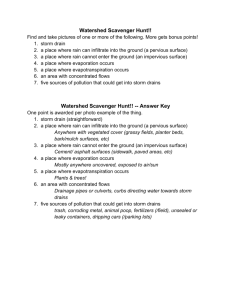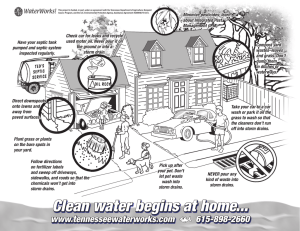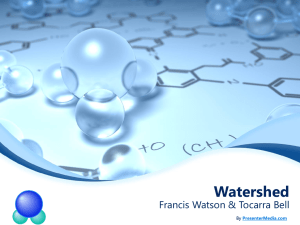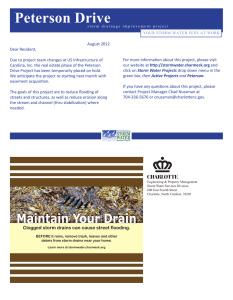Dry-season Water Quality in the San Gabriel River
advertisement
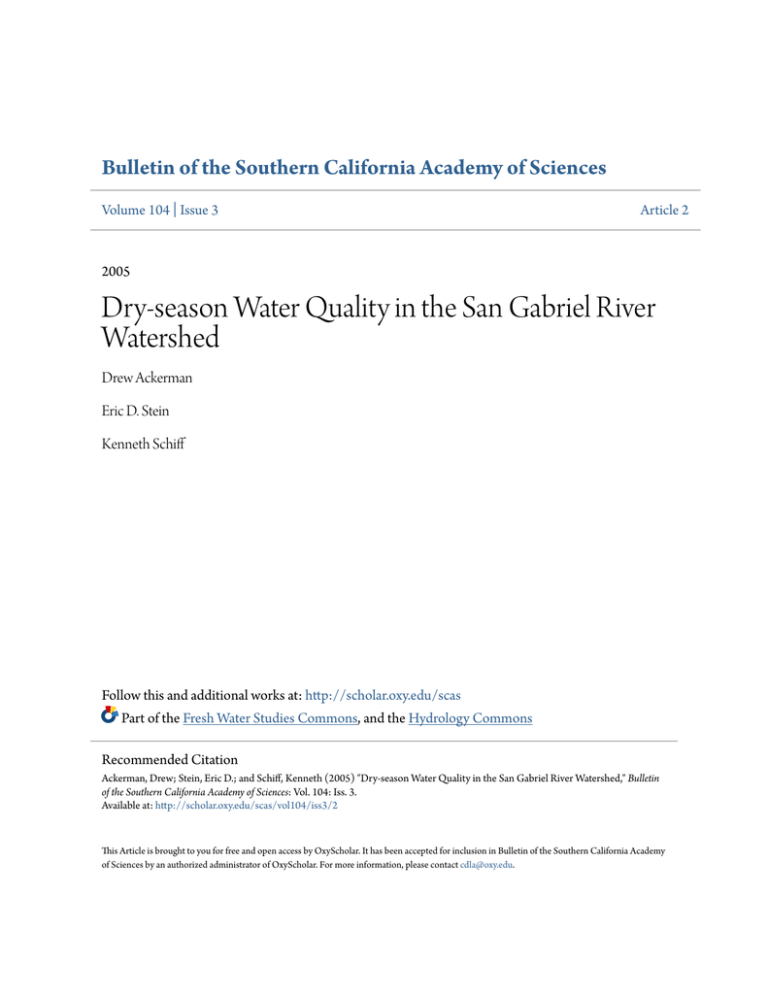
Bulletin of the Southern California Academy of Sciences Volume 104 | Issue 3 Article 2 2005 Dry-season Water Quality in the San Gabriel River Watershed Drew Ackerman Eric D. Stein Kenneth Schiff Follow this and additional works at: http://scholar.oxy.edu/scas Part of the Fresh Water Studies Commons, and the Hydrology Commons Recommended Citation Ackerman, Drew; Stein, Eric D.; and Schiff, Kenneth (2005) "Dry-season Water Quality in the San Gabriel River Watershed," Bulletin of the Southern California Academy of Sciences: Vol. 104: Iss. 3. Available at: http://scholar.oxy.edu/scas/vol104/iss3/2 This Article is brought to you for free and open access by OxyScholar. It has been accepted for inclusion in Bulletin of the Southern California Academy of Sciences by an authorized administrator of OxyScholar. For more information, please contact cdla@oxy.edu. Ackerman et al.: Dry-season Water Quality in the San Gabriel River Watershed Bull. Southern California Acad. Sci. 104(3), 2005, pp. 125–145 䉷 Southern California Academy of Sciences, 2005 Dry-season Water Quality in the San Gabriel River Watershed Drew Ackerman, Eric D. Stein, and Kenneth Schiff Southern California Coastal Water Research Project, 7171 Fenwick Lane, Westminster, California 92683 Abstract.—Dry-season flow in the San Gabriel River system is comprised mostly of discharges from water reclamation plants (WRPs), imported water, and storm drains. Although the magnitude of dry-season discharge is generally known, the water quality associated with most of these ‘‘introduced’’ discharges has not been characterized, nor has the associated in-stream response, particularly near storm drain discharges. The goal of this study was to characterize the pattern and magnitude of storm drain and WRP inputs to the San Gabriel River system and the associated in-stream response. To accomplish this, two synoptic dry-weather surveys were conducted, one in 2002 and the other in 2003 during which flow, metals, bacteria, and nutrient concentrations were measured from the WRPs, storm drains, and in-stream locations at a single point in time. For bacteria and most metals, storm drains accounted for the majority of mass emissions to the river. In contrast, WRPs were the primary source for nutrients. In-stream water quality concentrations generally reflected the main sources. For example, in-stream ammonia concentrations were highest downstream of WRP discharges. In-stream bacteria concentrations were consistently high and showed no apparent spatial pattern, suggesting that storm drains or other in-stream sources are present throughout the watershed. Urbanization has had many consequences on the hydrology of southern California’s coastal watersheds (Hamilton 1992; Schuler and Holland 2000; Roesner and Bledsoe 2003). Streams historically convey seasonal storm flows and are dry for large portions of the year. Today, large engineered channels have replaced most large streams and rivers to accommodate increases in storm water runoff. In addition, the historical intermittent hydroperiod has been replaced by yearround baseflow. In the San Gabriel watershed, the large engineered channels that predominate in the lower watershed receive dry-weather flow from a variety of ‘‘introduced’’ sources, such as water reclamation plant (WRP) discharges, other National Pollutant Discharge Elimination System (NPDES) discharges, storm drain discharges of non-point source runoff from the developed landscape, and imported water that is conveyed seasonally through the San Gabriel River and its tributaries to spreading grounds located throughout the watershed. Dry-season sources of water may include a suite of urban-generated constituents that have the potential to affect surface water quality adversely. For example, storm drains have been found to be the primary source of pollutants in the neighboring Los Angeles River watershed (Ackerman et al. 2003). Also, Bay et al. (1996) found that dry-weather runoff to the Santa Monica Bay contained toxic levels of certain constituents. Previously, documented concentrations of nutrients, 125 Published by OxyScholar, 2005 1 Bulletin of the Southern California Academy of Sciences, Vol. 104 [2005], Iss. 3, Art. 2 126 SOUTHERN CALIFORNIA ACADEMY OF SCIENCES metals, and bacteria have resulted in large portions of the lower San Gabriel watershed being listed as impaired under Section 303(d) of the Clean Water Act. Managing dry-season water quality requires an understanding of the water quality associated with the primary sources of dry-weather flow (i.e., storm drains and WRP discharges), and the relationship between these sources and in-stream water quality. Although hundreds of storm drains discharge to the 303(d) listed portions of the San Gabriel River and its tributaries, the spatial and temporal patterns of these inputs relative to those of the WRPs have not been quantified. Furthermore, the relative mass contribution of pollutants from storm drains and WRP discharges has not been investigated, nor has the response of in-stream water quality to these mass loadings. The goal of this study is to characterize storm drain and WRP inputs to the San Gabriel River system and the associated in-stream response. The relative contribution of non-point source (i.e., storm drain) and point source (i.e., WRP) inputs were quantified for bacteria, metals, and nutrients. The observed concentrations also were compared to existing water quality standards in order to provide managers with information that can be used in developing strategies to address water quality impairments. Methods This study is comprised of two parts. The first part consists of identifying and sampling the major inputs to the San Gabriel River and its major tributaries. The second part is comprised of sampling the in-stream water quality to assess spatial water quality patterns and the relationship between sources and in-stream water quality. Two synoptic surveys were conducted approximately one year apart during which approximately 85 storm drains and 16 in-river sites were sampled twice over a 2-day period each year. Watershed The 1,866 km2 San Gabriel River (SGR) watershed (Figure 1) is highly urbanized in its lower portions, and predominantly undeveloped in the upper watershed. The reaches that are listed as having impaired water quality and are the focus of this study are San Gabriel River, Coyote Creek (CC), San Jose Creek (SJC), and Walnut Creek (WC) (Table 1). Any storm drains, channels, or other discharges to these reaches were considered inputs to the system. Flow through the SGR system is highly managed by diversions and concrete and rubber dams that route water to various infiltration areas. As a result, dryweather flows are highly variable both within and between years (LACDPW 2004). For example, in Water Year (WY) 2002–03, the Los Angeles County Department of Public Works (LACDPW) imported 1.02 ⫻ 108 m3 of water (LACDPW 2004) and conveyed much of that water through the SJC and WC systems to spreading grounds. In that same year, 7.01 ⫻ 106 m3 of water from the San Jose Creek and Pomona WRPs was sent to spreading grounds, while 1.40 ⫻ 107 m3 was allowed to pass to the ocean (LACDPW 2004). The earthen bottom portions of the SGR are used for infiltration; therefore, although physically connected, the WC and SJC are often hydrologically discontinuous from the SGR during dry-weather conditions (Figure 2). http://scholar.oxy.edu/scas/vol104/iss3/2 2 Ackerman et al.: Dry-season Water Quality in the San Gabriel River Watershed SAN GABRIEL RIVER WATER QUALITY 127 Fig. 1. Map of the San Gabriel River watershed. Shown are the impaired streams, storm drain locations during the two surveys, in-stream sampling points, stream gages and water reclamation plant discharge locations. Input Sampling Inputs to the SGR watershed were sampled on September 29, 2002 and September 14, 2003. Point source inputs included four WRPs that discharge tertiary treated wastewater. The Los Coyotes WRP discharges to the SGR, the Long Beach WRP discharges to the CC, and the Pomona WRP discharges to the SJC. The San Jose Creek WRP discharges to both the SJC and SGR. The WRP effluent was collected as a 4-hour composite sample and analyzed for the parameters listed in Table 2. Inputs that convey non-point source discharge were sampled synoptically during each of the two sampling events. Non-point source inputs were classified as either ‘‘small storm drain’’ discharges or ‘‘large NPS’’ discharges. The latter consisted mainly of open channels that drain to the impaired reaches that are the focus of this study (Table 3). Prior to each sampling event, storm drains and large NPSs were surveyed to identify those that flow during the dry season. At each flowing storm drain or large NPS, flow was measured using either timed-volumetric or depth-velocity methods (as appropriate, given the conditions at the location). Water quality samples were collected directly by filling the sample bottle or using a sterilized scoop to collect the water sample. Samples were placed on ice and transported to the laboratories for analysis of the parameters listed in Published by OxyScholar, 2005 3 Bulletin of the Southern California Academy of Sciences, Vol. 104 [2005], Iss. 3, Art. 2 128 SOUTHERN CALIFORNIA ACADEMY OF SCIENCES Table 1. List of stream impairments and their lengths for the San Gabriel Watershed. Length (km) San Gabriel River 41 Coyote Creek 21 San Jose Creek Walnut Creek 32 19 Fig. 2. Impairment Algae, coliform, dissolved copper, lead, dissolved zinc, toxicity, abnormal fish histology Algae, coliform, dissolved copper, dissolved lead, total selenium, dissolved zinc, toxicity, abnormal fish histology Algae, coliform Toxicity, pH In-stream flow variability for the 2002 sampling survey by stream. http://scholar.oxy.edu/scas/vol104/iss3/2 4 Ackerman et al.: Dry-season Water Quality in the San Gabriel River Watershed SAN GABRIEL RIVER WATER QUALITY 129 Table 2. Constituents sampled during each survey along with the analytical method used and the reporting limit. Analytical Method Bacteria Generals Metals Enterococcus E Coli Fecal Coliform Total Coliform Hardness pH TSS Aluminum Arsenic Cadmium Chromium Copper Iron Lead Nutrients Nickel Selenium Zinc Ammonia Nitrate-Nitrite TKN Pesticides Dissolved Phosphorus Total Phosphorus Diazinon Quanti-Tray Quanti-Tray (2003) Membrane Filtration (2002) Quanti-Tray EPA 130.2 - titration EPA 150.1 EPA 160.2 - GF/C filtration EPA 200.7 - ICP/AES SM 3114 B4d - hydride generation EPA 213.2 - Stabilized temperature platform furnace EPA 200.7 - ICP/AES EPA 200.7 - ICP/AES EPA 200.7 - ICP/AES EPA 239.2 - Stabilized temperature platform furnace EPA 200.7 - ICP/AES SM 3114 B - hydride generation EPA 200.7 - ICP/AES SM 4500 NH3E - titrimetric distillation EPA300.0/SM 4500NO2 B - ion chromotography SM 4500 NorgB - organic N digestion ⫹ titrimetric distillation EPA 365.3 - spectrophotometric EPA 365.3 - spectrophotometric ELISA Reporting Limit 10 MPN/100mL 10 MPN/100mL 10 MPN/100mL 10 MPN/100mL 2 mg/L N/A 2 mg/L 50 ug/L 1 ug/L 0.4 ug/L 10 ug/L 8 ug/L 50 ug/L 2 ug/L 20 ug/L 1 ug/L 10 ug/L 100 ug/L 50 ug/L 100 ug/L 50 ug/L 50 ug/L 0.05 ug/L Table 2. The analytical methods and reporting limits for each constituent are listed in Table 2. In-stream Sampling The day after the storm drain sampling (September 30, 2002 and September 15, 2003), in-stream water quality samples were taken from each of the four study streams. Samples were taken at the upstream boundary of each reach, at the most downstream point, and at points between to characterize water quality changes (14 locations in total) (Figure 1). Six additional sites were added in 2003 to better resolve longitudinal in-stream water quality. Composite samples were collected by taking three grab samples over a 10-min period. A second composite sample was collected 20 min later, and a third composite was collected 40 min after the initial composite. The three samples were analyzed separately to characterize the short-term in-stream variability. Flow information was obtained from existing flow gages maintained by the Los Angeles County Department of Public Works. Data Analysis Flow and water quality data were analyzed for spatial and temporal patterns. Means and ranges of flow and concentration for all locations were analyzed by Published by OxyScholar, 2005 5 Bulletin of the Southern California Academy of Sciences, Vol. 104 [2005], Iss. 3, Art. 2 130 SOUTHERN CALIFORNIA ACADEMY OF SCIENCES Table 3. Large non-point source (NPS) discharges to the impaired reaches of the San Gabriel River Watershed. Receiving Water Reach Large NPS Discharge Coyote Creek Carbon Creek Brea Creek Fullerton Creek La Mirada Wash Lemon Creek Diamond Bar Wash Puente Creek Big Dalton Wash (includes San Dimas and Little Dalton Wash) San Jose Creek Walnut Creek individual sampling date and compared between sampling dates. Constituent loads were calculated by multiplying flow times concentration for each sample, as described in Schiff (1997): Load ⫽ 冘FC i i where Fi was the flow and Ci was the constituent concentration at location i. When multiple samples were averaged, results are presented as means ⫾ the 95% confidence interval. In all cases, nondetectable results were assigned a value of zero. Results One hundred storm drains and eight large NPS discharges were sampled over the two sampling periods. During the 2002 survey, 87 storm drains were sampled and the majority of those storm drains were in the SJC (Table 4). In 2003, 84 storm drains were sampled, with 58 of those drains being the same as the ones sampled in 2002. The same 6 large NPS discharges were sampled in both 2002 and 2003. Table 4. Measured flows (106 L d⫺1) and number of samples by stream reach and source category. Coyote San Gabriel 6 2002 Storm Drains Large NPS WRPs TOTAL Flow 10 L d⫺1 N 26.0 20.3 0.1 46.3 15 4 1 20 Coyote 2003 Storm Drains Large NPS WRPs TOTAL http://scholar.oxy.edu/scas/vol104/iss3/2 Flow 10 L d⫺1 n 7.5 — 238.5 246.0 19 0 2 21 San Gabriel Flow 106 L d⫺1 n 29.0 18.2 45.8 93.0 6 16 4 1 21 Flow 106 L d⫺1 N 3.9 — 255.5 259.4 10 0 2 12 San Jose Walnut 6 Flow 10 L d⫺1 N 35.0 2.5 142.7 180.1 32 1 3 36 San Jose Flow 10 L d⫺1 n 3.0 14.7 — 17.7 9 1 0 10 Walnut Flow 106 L d⫺1 N 33.0 16.3 213.5 259.4 Total 6 33 1 3 37 71.4 37.4 381.2 490.1 75 6 6 87 Total Flow 106 L d⫺1 n 4.2 9.6 — 13.8 Flow 106 L d⫺1 n 13 1 0 14 Flow 106 L d⫺1 n 70.1 44.0 514.8 629.0 72 6 6 84 6 Ackerman et al.: Dry-season Water Quality in the San Gabriel River Watershed SAN GABRIEL RIVER WATER QUALITY 131 Fig. 3. Distribution of observed storm drain flows by sampled stream (A) and by survey for all flowing storm drains sampled in the SGR watershed (B). Flow Nearly 80% of measured flow in the SGR watershed was from the WRPs during both surveys (Table 4). The majority originated from the San Jose Creek WRP, and discharged either to the confluence of San Jose Creek and San Gabriel River or through a pipeline that discharged to the San Gabriel River 16 km downstream of the confluence. Over 80% of the storm drains and large NPS discharges carried flows less than 28 L s⫺1 (1 cfs) (Figure 3). Flows over 5 L s⫺1 comprised the top 30% of the flowing drains and were comparable between the two surveys. Higher proportions of storm drains had small flows (i.e., below 5 L s⫺1) in 2002 as compared to 2003. These differences at storm drains with very low flow may be due to true interannual variability, but could also be an artifact of the inherent Published by OxyScholar, 2005 7 http://scholar.oxy.edu/scas/vol104/iss3/2 MPN/100mL MPN/100mL MPN/100mL mg/L ug/L ug/L ug/L ug/L ug/L ug/L mg/L mg/L mg/L mg/L Metals Hardness Chromium Copper Iron Lead Nickel Zinc Nutrients Ammonia-N Nitrate-Nitrite TKN Total Phosphate-P 2002 Results 0.01 0.03 0.02 0.05 2 10 8 50 2 20 10 10 10 10 MDL 0.77 3.36 3.16 0.50 356 0.14 15.0 572 2.60 7.39 134 17,600 1,210 177,000 Average 0.47 1.53 1.21 0.10 39.1 0.28 7.36 281 1.21 4.71 83.1 15,300 1,290 198.000 95% C.I. ND 0.05 0.49 1.62 0.08 28.3 368 1.67 7.00 1,940 3.00 29,400 2,990 1,020,000 Average —- 0.07 0.54 0.53 0.06 22.3 84.2 3.27 6.52 3,360 2.15 55,400 20,500 2,460,000 95% C.I. Large NPS Discharges 8.01 3.00 9.41 0.72 199 ND ND 44.2 ND ND 45.0 ND 0.26 2.13 Average 3.01 1.26 3.15 0.27 21.7 — — 30.4 — — 8.39 — 0.72 4.89 95% C.I. WRPs 132 Bacteria Enterococcus Fecal Coliforms Total Coliforms Storm Drains Table 5. Mean of observed concentrations and 95th percent confidence interval by source. Geometric means are reported for bacteria samples; arithmetic means are reported for all other constituents. Nondetectable samples were assumed to be zero. Note that in 2002 Fecal Coliforms were measured, whereas in 2003 E. coli was measured. Bulletin of the Southern California Academy of Sciences, Vol. 104 [2005], Iss. 3, Art. 2 SOUTHERN CALIFORNIA ACADEMY OF SCIENCES 8 Published by OxyScholar, 2005 10 10 10 MPN/100ml MPN/100mL MPN/100mL mg/L ug/L ug/L ug/L ug/L ug/L ug/L mg/L mg/L mg/L mg/L ng/L Metals Hardness Chromium Copper Iron Lead Nickel Zinc Nutrients Ammonia-N Nitrate-Nitrite TKN Total Phosphate-P Diazinon 0.01 0.03 0.02 0.05 50 2 10 8 50 2 20 10 MDL 2003 Results Bacteria Enterococus E. coli Total Coliforms ND 0.33 2.87 1.86 0.45 122 8.00 394 1.57 0.69 99.3 343 650 10,400 21,800 Average — 0.34 1.53 0.59 0.11 77.6 3.30 138 0.63 1.36 22.7 4.09 658 9,070 21,400 95% C.I. Storm Drains Table 5. Continued. ND ND 0 1.96 1.67 0.10 83.9 57.1 3.00 453 1.92 408 1,660 9,080 29,900 Average — —- — 2.55 0.56 0.05 38.7 13.3 3.10 203 1.12 80.2 363 4,500 11,400 95% C.I. Large NPS Discharges 18.9 — — 36.0 — — 7.08 — 5.09 — 95% C.I. 1.40 0.35 3.00 0.73 2.62 0.46 0.43 0.16 No data available 190 ND ND 36.84 ND ND 72.4 ND 0.93 ND Average WRPs Ackerman et al.: Dry-season Water Quality in the San Gabriel River Watershed SAN GABRIEL RIVER WATER QUALITY 133 9 Bulletin of the Southern California Academy of Sciences, Vol. 104 [2005], Iss. 3, Art. 2 134 SOUTHERN CALIFORNIA ACADEMY OF SCIENCES variability associated with measuring storm drain flows, which increases dramatically in drains with low discharge. Water Quality The mean concentration of water quality constituents varied by source (Table 5). The WRPs had the highest nutrient concentrations (e.g. 3.0 mg/L of nitratenitrite vs. 0.03 mg/L for storm drains). Storm drains and large NPS discharges had the highest bacteria concentrations (e.g. 104–105 MPN/100 ml of total coliforms vs. ⬍101 MPN/100ml for WRPs). Metal concentrations were generally higher in the storm drain and large NPS discharges than from WRPs, but there were some differences based on individual metals. In general, metals concentrations were lower in large NPS discharge tributaries than in small storm drains. Concentrations and loads from WRP and non-point source inputs generally were higher in 2002 than in 2003. For example, total coliform concentrations from storm drains and large NPS discharges were between 10 and 30 times higher in 2002 than in 2003, while loads were between 9 and 50 times higher in 2002 (Figure 4). Similarly, fecal coliform loads in 2002 were up to 40 times higher than E. coli loads in 2003. Assuming fecal coliforms are comprised of approximately 80% E. coli, the loads would still have been more than 30% higher in 2002 than in 2003. Metals concentrations were also higher in 2002 (with the exception of zinc), but were typically within the same order of magnitude during both surveys. Overall, daily loads of copper were 2 times higher in 2002 than in 2003; however, in 2002 small storm drains accounted for a substantially lower proportion of copper relative to large NPS discharges than in 2003 (Figure 4). Bacteria and metals data were approximately the same for the WRPs between the two surveys. However, nutrient concentrations were generally 50% lower during the 2003 survey, due to operational changes at the WRPs. Source Comparison to Standards Water quality from the storm drains frequently exceeded water quality standards for bacteria. The bacteria levels observed in storm drain flows (Figure 5) exceeded water quality standards in 98% of the sampled drains. In contrast, in-river metals concentrations never exceeded the hardness-adjusted acute water quality standards under the California Toxics Rule (CTR; Figure 6). Although the CTR generally applies only to receiving waters and not to storm drain or NPS discharges, such a comparison is instructive for identifying potentially problematic discharges. In general, storm drain and large NPS discharges were also below CTR standards, except for copper, which exceeded acute CTR standards in 4% to 8% of the storm drain and large NPS inputs; and zinc, which exceeded chronic CTR standards in 2% to 8% of the storm drain and large NPS inputs (Figures 5 and 6, Table 6). Mass Emission The major pollutant sources to the SGR watershed differed by constituent (Table 7). The WRPs contributed approximately 90% or more of the nutrient mass loadings to the system. In contrast, almost all bacteria loading was contributed by storm drains and large NPS discharges. In 2002, the eight large NPS discharges accounted for over twice as much bacteria load to the system as the small storm drains, despite having less flow. In contrast, in 2003, the bacteria load from large http://scholar.oxy.edu/scas/vol104/iss3/2 10 Ackerman et al.: Dry-season Water Quality in the San Gabriel River Watershed SAN GABRIEL RIVER WATER QUALITY 135 Fig. 4. Comparison of daily loads between 2002 and 2003 for bacteria (top) and metals (bottom). Values are in magnitude difference. Bars below the line indicate higher loads in 2002; bars above the line indicate higher loads in 2003. Published by OxyScholar, 2005 11 Bulletin of the Southern California Academy of Sciences, Vol. 104 [2005], Iss. 3, Art. 2 136 SOUTHERN CALIFORNIA ACADEMY OF SCIENCES Fig. 5. Distribution of observed storm drain water quality concentrations by year. NPS discharges was lower than that from small storm drains. The relative mass emission of trace metals varied by source and by metal. In 2002, the large NPS discharges accounted for twice as much copper, iron, and lead relative to the small storm drains; in 2003, copper and iron emissions were higher in small storm drains than in the large NPS discharges. In both years, loadings of copper, lead, and nickel from the WRPs was minimal; however, the WRPs contributed the majority of zinc loading and between 12% and 51% of lead loading. Coyote Creek and the San Gabriel/San Jose Creek confluence area received the greatest mass loadings of pollutants of the four streams (Table 8). The large bacteria loading to Coyote Creek reflected the large storm drain volumetric inputs (Table 4). Large nutrient loadings in the SJC corresponded to large volumetric discharges from the San Jose WRP (214 ⫻ 106 L d⫺1 in 2002). Walnut Creek received no WRP input and had volumetric loadings less than half of the CC and SJC. Despite its low flow relative to other portions of the system, bacteria loadings http://scholar.oxy.edu/scas/vol104/iss3/2 12 Ackerman et al.: Dry-season Water Quality in the San Gabriel River Watershed SAN GABRIEL RIVER WATER QUALITY Fig. 6. 137 Measured hardness-dependent copper toxicity by source and year. Table 6. Percent of all samples (i.e., storm drains, large non-point source inputs, and WRP discharges) that exceeded the hardness-adjusted acute and chronic California Toxics Rule (CTR) metals criteria by year. Acute Criteria Cadmium Chromium Copper Lead Nickel Silver Zinc Published by OxyScholar, 2005 Chronic Criteria 2002 2003 2002 2003 1% 0% 5% 0% 0% 0% 5% 0% 0% 2% 0% 0% 0% 1% 1% 0% 10% 2% 0% 0% 5% 0% 0% 7% 3% 0% 0% 1% 13 Bulletin of the Southern California Academy of Sciences, Vol. 104 [2005], Iss. 3, Art. 2 138 SOUTHERN CALIFORNIA ACADEMY OF SCIENCES Table 7. Total mass emission by source for the two dry-weather sampling events. Samples with non-detectable values are treated as zero. Percent Contribution Consituent 2002 Bacteria Fecal Coliforms Enterococcus Total Coliforms Total Mass Emissions 1,800 948 48,300 Metals Copper Iron Lead Nickel Zinc Nutrients Ammonia-N Nitrate-Nitrite TKN Total Phosphorous 2003 Bacteria E. coli Enterococcus Total Coliforms 0.0285 7.94 0.0083 0.0023 0.79 87.6 69.1 113 7.67 800 1,110 2,090 Metals Copper Iron Lead Nickel Zinc Nutrients Ammonia-N Nitrate-Nitrite TKN Total Phosphorous 0.014 2.81 0.0060 0.0003 1.74 26.6 66.6 57.9 7.19 Units Storm Drains Large NPS Discharges WRPs (109) hr⫺1 (109) hr⫺1 (109) hr⫺1 34% 35% 28% 66% 65% 72% 0% 0% 0% kg kg kg kg kg hr⫺1 hr⫺1 hr⫺1 hr⫺1 hr⫺1 38% 30% 29% 100% 14% 62% 58% 71% 0% 8% 0% 12% 0% 0% 78% kg kg kg kg hr⫺1 hr⫺1 hr⫺1 hr⫺1 1% 5% 3% 8% 0% 1% 2% 1% 99% 94% 95% 90% (109) hr⫺1 (109) hr⫺1 (109) hr⫺1 91% 58% 68% 9% 42% 32% 0% 0% 0% kg kg kg kg kg hr⫺1 hr⫺1 hr⫺1 hr⫺1 hr⫺1 100% 33% 25% 100% 11% 0% 16% 75% 0% 7% 0% 51% 0% 0% 82% kg kg kg kg hr⫺1 hr⫺1 hr⫺1 hr⫺1 1% 8% 7% 6% 0% 2% 3% 4% 99% 90% 89% 89% from Walnut Creek in 2003 nearly equaled those in the CC and SJC. High loadings in WC are attributed mainly to high in-stream concentrations, which are more than 200% higher than those of the other streams. In-stream Concentrations The spatial distribution of pollutants throughout the four reaches in the SGR watershed reflects the influence of major mass emission sources (Figures 7–9). For nutrients, in-stream ammonia levels in the SJC and the SGR were markedly higher downstream of the Pomona, San Jose Creek, and Los Coyotes WRPs (Figure 7). Where storm drains were the only inputs; i.e., upper Coyote Creek and Walnut http://scholar.oxy.edu/scas/vol104/iss3/2 14 Ackerman et al.: Dry-season Water Quality in the San Gabriel River Watershed SAN GABRIEL RIVER WATER QUALITY 139 Table 8. Total mass emission by creek for the two dry-weather sampling events. Percent Contribution Consituent 2002 Bacteria Fecal Coliforms Enterococcus Total Coliforms Metals Copper Iron Lead Nickel Zinc Nutrients Ammonia-N Nitrate-Nitrite TKN Total Phosphorous 2003 Bacteria E. coli Enterococcus Total Coliforms Metals Copper Iron Lead Nickel Zinc Nutrients Ammonia-N Nitrate-Nitrite TKN Total Phosphorous Total Mass Emissions 1,800 948 48,300 0.0285 7.94 0.0083 0.0023 0.79 87.6 69.1 113 7.67 315 1,110 2,090 0.014 2.81 0.0060 0.0003 1.74 26.6 66.6 57.9 7.19 Units Coyote Creek San Gabriel San Jose River Creek Walnut Creek (109) hr⫺1 (109) hr⫺1 (109) hr⫺1 66% 62% 62% 5% 20% 14% 17% 10% 16% 12% 7% 8% kg kg kg kg kg hr⫺1 hr⫺1 hr⫺1 hr⫺1 hr⫺1 22% 58% 55% 9% 8% 12% 9% 14% 50% 53% 20% 31% 8% 36% 36% 46% 2% 24% 0% 3% kg kg kg kg hr⫺1 hr⫺1 hr⫺1 hr⫺1 0% 2% 2% 5% 55% 67% 55% 54% 45% 31% 42% 41% 0% 0% 1% 0% (109) hr⫺1 (109) hr⫺1 (109) hr⫺1 36% 40% 33% 0% 4% 2% 28% 44% 49% 35% 11% 15% kg kg kg kg kg hr⫺1 hr⫺1 hr⫺1 hr⫺1 hr⫺1 49% 13% 11% 0% 16% 2% 27% 1% 0% 43% 29% 50% 39% 100% 38% 20% 10% 50% 0% 3% kg kg kg kg hr⫺1 hr⫺1 hr⫺1 hr⫺1 10% 10% 14% 21% 63% 53% 53% 46% 27% 36% 31% 31% 0% 1% 2% 3% Creek, nutrient concentrations were consistently low. Bacteria concentrations were generally high throughout all stream reaches, with no apparent spatial pattern (Figure 8). In some cases, metals concentrations appeared to reflect the locations of large inputs. For example, the 2002 in-stream copper concentrations were higher near the locations where large storm drains discharged (Figure 8). Discussion The characteristics and patterns of dry-season water quality observed in the SGR watershed are comparable to those seen in the neighboring urbanized watersheds, such as the Los Angeles River (LAR) watershed (Ackerman et al. 2003) and Ballona Creek watershed (Stein and Tiefenthaler 2004). Similar to the LAR, Published by OxyScholar, 2005 15 Bulletin of the Southern California Academy of Sciences, Vol. 104 [2005], Iss. 3, Art. 2 140 SOUTHERN CALIFORNIA ACADEMY OF SCIENCES Fig. 7. In-stream ammonia concentrations by stream and year (vertical arrows show WRP locations). In Figure 7b, 0 km is the confluence of San Jose Creek and the San Gabriel River. the WRPs were determined to be the major source of flow and nutrients (there are no WRP discharges into Ballona Creek). Non-point source discharges are the major source of bacteria in all three watersheds. Similar to the LAR watershed, the source of metals loading varied by individual metal, with storm drains being the predominant source of most metals. In both the LAR and the SGR, WRPs were the predominant source of zinc. Unlike the LAR watershed, however, copper loading resulted primarily from storm drains in the SGR. This difference is likely due to higher detection limits used in the LAR study (e.g. in the LAR study, lead and iron detection limits were 10 and 200 ug/L, respectively and in this study 2 and 50 ug/L), which resulted in many more storm drain samples having ‘‘nondetect’’ values, causing the WRPs to appear to be the major source of copper. This conclusion is further supported by the fact that storm drain concentrations http://scholar.oxy.edu/scas/vol104/iss3/2 16 Ackerman et al.: Dry-season Water Quality in the San Gabriel River Watershed SAN GABRIEL RIVER WATER QUALITY 141 Fig. 8. In-stream Enterococcus concentrations by stream and year (vertical arrows show WRP locations). In Figure 8b, 0 km is the confluence of San Jose Creek and the San Gabriel River. in the SGR were comparable to those observed in Ballona Creek, where detection limits were similar to those used in the SGR. The manner in which samples with nondetectable levels of a particular metal were treated may affect conclusions regarding distribution of load among sources. The degree that nondetectable values influence general conclusions about loading depends on the frequency of nondetectable values. In our analyses, we assumed that samples below the detection limit had a concentration of zero. Due to the large volume input by the WRPs, small differences in these estimates can have a dramatic effect on the overall distribution of trace metal sources (Figure 10). For example, assuming that nondetectable samples for nickel were equal to a concentration of zero led to an estimation that storm drains account for 100% of the nickel mass. If this assumption were changed to a concentration equal to one-half Published by OxyScholar, 2005 17 Bulletin of the Southern California Academy of Sciences, Vol. 104 [2005], Iss. 3, Art. 2 142 SOUTHERN CALIFORNIA ACADEMY OF SCIENCES Fig. 9. In-stream copper concentrations by stream and year (vertical arrows show WRP locations). In Figure 9b, 0 km is the confluence of San Jose Creek and the San Gabriel River. the detection limit, the WRPs would become the dominant source for nickel as well as five of the six other metals analyzed. Although the magnitude of constituent concentrations varied from year to year, the general spatial patterns were consistent. For example, the ranges of measured storm drain flow and the distribution of flow among storm drains and between streams was generally consistent (Figure 2). Likewise, the pattern of storm drain concentrations for a given class of constituents was consistent between the two sampling events. For example, relatively few drains had high concentrations of metals and nutrients, whereas most drains had high concentrations of bacteria (Figure 4). The ubiquitously high bacteria concentrations reflect a consistent source being generated from the urban land uses in the watershed. Other non- http://scholar.oxy.edu/scas/vol104/iss3/2 18 Ackerman et al.: Dry-season Water Quality in the San Gabriel River Watershed SAN GABRIEL RIVER WATER QUALITY 143 Fig. 10. The effect of detection limits on the aggregated trace metal loadings using data from both sampling events. human sources, such as horses, birds, and dogs, and in-channel growth likely also contribute to the high levels observed. In general, spatial patterns of in-stream water quality correspond to the locations of dominant discharges for each constituent. For example, in-stream nutrient concentrations were highest downstream of WRP discharges, whereas in-stream metals concentrations were highest downstream of areas where storm drains with high metals concentrations discharged. The consistently high bacteria concentrations throughout the system make estab- Published by OxyScholar, 2005 19 Bulletin of the Southern California Academy of Sciences, Vol. 104 [2005], Iss. 3, Art. 2 144 SOUTHERN CALIFORNIA ACADEMY OF SCIENCES lishing linkages between sources and receiving water concentrations more difficult. In addition, potential in-stream sources of bacteria (e.g., birds or regrowth) were not evaluated in this study. Nevertheless, the patterns observed in this study were consistent with those observed in the LAR and Ballona watersheds and generally indicate a direct link between source inputs and in-river concentrations. Inter-annual variability in metals concentrations was similar to or slightly less than the typical ranges seen in Ballona Creek and LAR (Ackerman et al. 2003). However, inter-annual variations in bacteria concentrations were higher than typically seen in other systems. This may be due to the lack of replication in this study, which would serve to amplify the inherently large fluctuations often seen in bacteria concentrations. Because the goal of this study was to provide a synoptic view of water quality, increased spatial coverage of samples was prioritized over replication at individual locations. Inclusion of such replication would have likely reduced inter-annual variability in bacteria concentrations. Nevertheless, the pattern of high concentration of bacteria in both source inputs and receiving waters was consistent between years. In contrast, differences in nutrient loading from the WRPs between 2002 and 2003 (and the resultant in-stream concentrations) were a result of changes in treatment practices (Figures 6b and 6c). In the interval between the two surveys, nitrification and denitrification facilities were installed at the WRPs. Decreases in measured average ammonia concentrations in the WRP effluent from 8.01 to 1.40 mg/L between 2002 and 2003 reflect this additional level of treatment. Similarly, in-stream concentrations downstream of the WRP discharges also decreased from 2002 to 2003. For example, the median ammonia concentration downstream of the San Jose Creek WRP decreased from 5.3 to 0.6 mg/L. This significant decrease in ammonia further demonstrates the influence of this source on in-stream water quality. Conclusions The results from this study are similar to those seen in the Los Angeles River. Storm drains were the primary source of bacteria and most metals, while the WRPs the main source of nutrients. The instream water quality reflects these inputs and was consistent between the two samplings. The storm drain water quality concentrations and flow were highly variable; however, but variability was similar between the two surveys. Acknowledgements This study was funded by the Los Angeles Regional Water Quality Control Board, the Los Angeles County Sanitation Districts, the Los Angeles County Department of Public Works, the City of Downey, and the Southern California Coastal Water Research Project (SCCWRP). The authors would like to acknowledge the assistance of the Los Angeles/San Gabriel Rivers Watershed Council, Friends of the San Gabriel River, and U.S. EPA Region IX. The authors are greatly indebted to the many citizen volunteers who volunteered for a day of training and a day of sample collection for each survey. Without their participation, the comprehensive characterization of the watershed would not have been nearly as complete. http://scholar.oxy.edu/scas/vol104/iss3/2 20 Ackerman et al.: Dry-season Water Quality in the San Gabriel River Watershed SAN GABRIEL RIVER WATER QUALITY 145 Literature Cited Ackerman, D., K. Schiff, H. Trim and M. Mullin. 2003. Characterization of water quality in the Los Angeles River. Bulletin of the Southern California Academy of Sciences 102: 17–25. Bay, S.M., D.J. Greenstein, S.-L. Lau, M.K. Stenstrom and C.G. Kelley. 1996. Toxicity of dry weather flow from the Santa Monica Bay Watershed. Bulletin of Southern California Academy of Sciences 95: 33–45. Hamilton, D.M. 1992. Hydrologic Assessment for Riparian Restoration Projects. Paper presented at the Environmental Engineering, Saving a Threatened Resource in Search of Solutions, Proceedings of Environmental Engineering Sessions Water Forum ’92, Baltimore, Maryland. LACDPW. Los Angeles County Department of Public Works. 2004. Imported and Reclaimed Water Data 2002–2003 Final. 具http://www.ladpw.org/wrd/spreadingground/watercon/典, April 29, 2004. Roesner, L.A. and B.P. Bledsoe. 2003. Physical Effects of Wet Weather Flows on Aquatic Habitats: Present Knowledge and Reasearch Needs. Water Environment Research Foundation. Fort Collins, CO. Schiff, K. 1997. Review of existing stormwater monitoring programs for estimating Bight-wide mass emissions from urban runoff. pp. 44–55 in: D. Hallock (ed.), Southern California Coastal Water Research Project Annual Report 1995–96. Westminster, CA. Schueler, T.R. and H.K. Holland. 2000. The Practice of Watershed Protection. Center for Watershed Protection. Ellicott City, MD. Stein, E.D. and L.L Tiefenthaler. 2004. Characterization of dry weather metals and bacteria in Ballona Creek. Southern California Coastal Water Research Project Technical Report #427. Accepted for publication 22 December 2004. Published by OxyScholar, 2005 21

